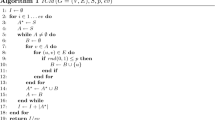Abstract
Over the last decade, the problem of optimizing influence diffusion in a social network has drawn much attention. In this paper, we study the problem of minimizing the complete influence time in a social network where the cost for targeting each individual is with fuzzy uncertainty. By adopting three different decision criteria in the area of uncertain programming, we propose three decision models to characterize the problem we study. In view of the complexity of the problem, we design a hybrid intelligence algorithm to solve models, where fuzzy simulation technologies are integrated with a modified greedy algorithm. Finally, numerical experiments are preformed to show the effectiveness of the models and algorithm we propose.






Similar content being viewed by others
References
Bimpikis K, Ozdaglar A, Yildiz E (2016) Competitive targeted advertising over networks. Oper Res 64(3):705–720
Charnes A, Cooper WW (1959) Chance-constrained programming. Manag Sci 6(1):73–79
Chen N (2008) On the approximability of influence in social networks. In: Nineteenth ACM-SIAM symposium on discrete algorithms. SIAM, pp 1029–1037
Chvatal V (1979) A greedy heuristic for the set-covering problem. Math Oper Res 4(3):233–235
Domingos P, Richardson M (2001) Mining the network value of customers. In: ACM SIGKDD international conference on knowledge discovery and data mining. ACM, pp 57–66
Doo M, Liu L (2014) Probabilistic diffusion of social influence with incentives. IEEE Trans Serv Comput 7(7):387–400
Erdos P, Renyi A (1959) On random graphs I. Publ Math 6:290–297
Goldenberg J, Libai B, Muller E (2001) Talk of the network: a complex systems look at the underlying process of word-of-mouth. Mark Lett 12(3):211–223
Goldenberg J, Libai B, Muller E (2001) Using complex systems analysis to advance marketing theory development: modeling heterogeneity effects on new product growth through stochastic cellular automata. Acad Mark Sci Rev 9(3):1–18
Goyal A, Lu W, Lakshmanan LV (2011) Celf++: optimizing the greedy algorithm for influence maximization in social networks. In: Proceedings of the 20th international conference companion on world wide web. ACM, pp 47–48
Granovetter M (1978) Threshold models of collective behavior. Am J Soc 83:1420–1443
Jendoubi S, Martin A, Lietard L, Ben Hadji H, Ben Yaghlane B (2017) Two evidential data based models for influence maximization in Twitter. Knowl Based Syst 121:58–70
Kempe D, Kleinberg J, Tardos É (2003) Maximizing the spread of influence through a social network. In: Proceedings of the ninth ACM SIGKDD international conference on knowledge discovery and data mining (KDD 2003). ACM, pp 137–146
Kim D, Hyeon D, Oh J, Han WS, Yu H (2017) Influence maximization based on reachability sketches in dynamic graphs. Inf Sci 394:217–231
Kosmides P, Demestichas K, Adamopoulou E, Remoundou C, Loumiotis I, Theologou M, Anagnostou M (2016) Providing recommendations on location-based social networks. J Ambient Intell Hum Comput 7(4):567–578
Liu B (1997) Dependent-chance programming: a class of stochastic optimization. Comput Math Appl 34(12):89–104
Liu B (1999) Dependent-chance programming with fuzzy decisions. IEEE Trans Fuzzy Syst 7(3):354–360
Liu B (2004) Uncertainty theory. Springer, Berlin
Liu YK, Gao J (2007) The independence of fuzzy variables in credibility theory and its applications. Int J Uncertain Fuzz 15(2):1–20
Lu F, Zhang W, Shao L, Jiang X, Xu P, Jin H (2017) Scalable influence maximization under independent cascade model. J Netw Comput Appl 86:15–23
Nahmias S (1978) Fuzzy variables. Fuzzy Set Syst 1(2):97–110
Ni Y (2017) Sequential seeding to optimize influence diffusion in a social network. Appl Soft Comput 56:730–737
Ni Y, Shi Q (2013) Minimizing the complete influence time in a social network with stochastic costs for influencing nodes. Int J Uncertain Fuzz 21:63–74
Ni Y, Xie L, Liu ZQ (2010) Minimizing the expected complete influence time of a social network. Inf Sci 180(13):2514–2527
Ni Y, Ning L, Ke H, Ji X (2017) Modeling and minimizing information distortion in information diffusion through a social network. Soft Comput. doi:10.1007/s00500-016-2277-9
Samadi M, Nikolaev A, Nagi R (2016) A subjective evidence model for influence maximization in social networks. Omega Int J Manag Sci 59:263–278
Tong G, Wu W, Tang S, Du DZ (2017) Adaptive influence maximization in dynamic social networks. IEEE/ACM Trans Netw 25(1):112–125
Wang Q, Jin Y, Lin Z, Cheng S, Yang T (2016) Influence maximization in social networks under an independent cascade-based model. Phys A 444:20–34
Wang X, Zhang Y, Zhang W, Lin X, Chen C (2017) Bring order into the samples: a novel scalable method for influence maximization. IEEE Trans Knowl Data Eng 29(2):243–256
Wang X, Zhang Y, Zhang W, Lin X (2017) Efficient distance-aware influence maximization in Geo-social networks. IEEE Trans Knowl Data Eng 29(3):599–612
Zadeh LA (1965) Fuzzy sets. Inf Control 8(3):338–353
Zhang K, Du H, Feldman MW (2017) Maximizing influence in a social network: improved results using a genetic algorithm. Phys A 478:20–30
Acknowledgements
This work was supported by National Natural Science Foundation of China (No. 71471038) and Program for Huiyuan Distinguished Young Scholars, UIBE.
Author information
Authors and Affiliations
Corresponding author
Rights and permissions
About this article
Cite this article
Ni, Y., Shi, Q. & Wei, Z. Optimizing influence diffusion in a social network with fuzzy costs for targeting nodes. J Ambient Intell Human Comput 8, 819–826 (2017). https://doi.org/10.1007/s12652-017-0552-y
Received:
Accepted:
Published:
Issue Date:
DOI: https://doi.org/10.1007/s12652-017-0552-y




